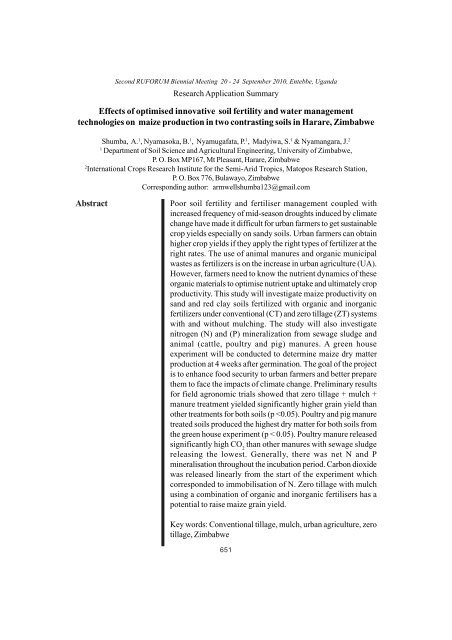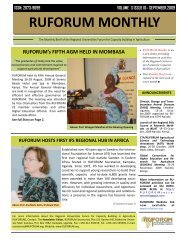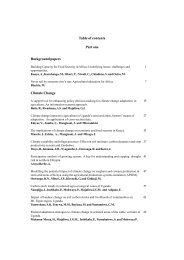Abstract Effects of optimised innovative soil fertility and water ...
Abstract Effects of optimised innovative soil fertility and water ...
Abstract Effects of optimised innovative soil fertility and water ...
Create successful ePaper yourself
Turn your PDF publications into a flip-book with our unique Google optimized e-Paper software.
<strong>Abstract</strong><br />
Second RUFORUM Biennial Meeting 20 - 24 September 2010, Entebbe, Ug<strong>and</strong>a<br />
Research Application Summary<br />
<strong>Effects</strong> <strong>of</strong> <strong>optimised</strong> <strong>innovative</strong> <strong>soil</strong> <strong>fertility</strong> <strong>and</strong> <strong>water</strong> management<br />
technologies on maize production in two contrasting <strong>soil</strong>s in Harare, Zimbabwe<br />
Shumba, A. 1 , Nyamasoka, B. 1 , Nyamugafata, P. 1 , Madyiwa, S. 1 & Nyamangara, J. 2<br />
1 Department <strong>of</strong> Soil Science <strong>and</strong> Agricultural Engineering, University <strong>of</strong> Zimbabwe,<br />
P. O. Box MP167, Mt Pleasant, Harare, Zimbabwe<br />
2 International Crops Research Institute for the Semi-Arid Tropics, Matopos Research Station,<br />
P. O. Box 776, Bulawayo, Zimbabwe<br />
Corresponding author: armwellshumba123@gmail.com<br />
Poor <strong>soil</strong> <strong>fertility</strong> <strong>and</strong> fertiliser management coupled with<br />
increased frequency <strong>of</strong> mid-season droughts induced by climate<br />
change have made it difficult for urban farmers to get sustainable<br />
crop yields especially on s<strong>and</strong>y <strong>soil</strong>s. Urban farmers can obtain<br />
higher crop yields if they apply the right types <strong>of</strong> fertilizer at the<br />
right rates. The use <strong>of</strong> animal manures <strong>and</strong> organic municipal<br />
wastes as fertilizers is on the increase in urban agriculture (UA).<br />
However, farmers need to know the nutrient dynamics <strong>of</strong> these<br />
organic materials to optimise nutrient uptake <strong>and</strong> ultimately crop<br />
productivity. This study will investigate maize productivity on<br />
s<strong>and</strong> <strong>and</strong> red clay <strong>soil</strong>s fertilized with organic <strong>and</strong> inorganic<br />
fertilizers under conventional (CT) <strong>and</strong> zero tillage (ZT) systems<br />
with <strong>and</strong> without mulching. The study will also investigate<br />
nitrogen (N) <strong>and</strong> (P) mineralization from sewage sludge <strong>and</strong><br />
animal (cattle, poultry <strong>and</strong> pig) manures. A green house<br />
experiment will be conducted to determine maize dry matter<br />
production at 4 weeks after germination. The goal <strong>of</strong> the project<br />
is to enhance food security to urban farmers <strong>and</strong> better prepare<br />
them to face the impacts <strong>of</strong> climate change. Preliminary results<br />
for field agronomic trials showed that zero tillage + mulch +<br />
manure treatment yielded significantly higher grain yield than<br />
other treatments for both <strong>soil</strong>s (p
Résumé<br />
Background<br />
Shumba, A. et al.<br />
La pauvre fertilité des sols et la pauvre gestion des engrais,<br />
conjuguées avec une fréquence accrue des sécheresses de la<br />
mi-saison provoquées par les changements climatiques, l’ont<br />
rendue difficile pour les agriculteurs urbains afin d’obtenir des<br />
rendements durables des cultures en particulier sur les sols<br />
sableux. Les agriculteurs urbains peuvent obtenir des rendements<br />
plus élevés s’ils appliquent de bons types d’engrais à de bons<br />
taux. L’utilisation de fumiers et de déchets organiques ménagers<br />
comme engrais est en hausse dans l’agriculture urbaine (AU).<br />
Toutefois, les agriculteurs ont besoin de connaître la dynamique<br />
des nutriments de ces substances organiques afin d’optimiser<br />
l’absorption des nutriments et la productivité des cultures en fin<br />
de compte. Cette étude portera sur la productivité du maïs dans<br />
les sols sablonneux et les sols d’argile rouge fertilisés par des<br />
engrais organiques et inorganiques dans les systèmes de<br />
labourage classique (CT) et de culture sans labour (ZT) avec et<br />
sans paillage. L’étude examinera également la minéralisation<br />
de l’azote (N) et du phosphore (P) à partir des vidanges et des<br />
fumiers d’animaux (bétail, volailles et porcs). Une expérience<br />
dans la serre sera menée pour déterminer la production de<br />
matière sèche de maïs, 4 semaines après la germination.<br />
L’objectif du projet est d’améliorer la sécurité alimentaire des<br />
agriculteurs urbains et mieux les préparer à faire face aux<br />
impacts du changement climatique. Les résultats préliminaires<br />
pour les essais agronomiques sur terrain ont montré que la culture<br />
sans labour + paillage + traitement des engrais a donné le<br />
rendement en grain nettement plus élevé que d’autres traitements<br />
pour les deux sols (p
Literature Summary<br />
Second RUFORUM Biennial Meeting 20 - 24 September 2010, Entebbe, Ug<strong>and</strong>a<br />
income groups (Tsuro, 2006) for food security <strong>and</strong> to augment<br />
family incomes. In Harare, 60% <strong>of</strong> the food consumed by lowincome<br />
groups is self-produced through UA <strong>and</strong> 40% <strong>of</strong> the<br />
farmers produce enough food to cover half a year’s consumption<br />
(Toriro, 2007). Crop production is largely rain-fed <strong>and</strong> it suffers<br />
from unpredictable rainfall regimes which are intensifying as<br />
climate change impacts become more severe. Harare<br />
experienced more severe midseason droughts in the past two<br />
seasons (2007/2008 <strong>and</strong> 2008/2009) resulting in crop failure <strong>and</strong><br />
low yields especially on s<strong>and</strong>y <strong>soil</strong>s. Furthermore, inputs like<br />
inorganic fertilizers are beyond farmers’ reach (Hungwe, 2007).<br />
These harsh conditions have prompted urban farmers in Harare<br />
to use organic <strong>and</strong> inorganic amendments such as farmyard<br />
manure, woodl<strong>and</strong> litter, sewage sludge <strong>and</strong> termitaria to fertilize<br />
their crops. However, nutrient dynamics <strong>of</strong> these organic<br />
materials used as fertilizers is not well understood. An<br />
underst<strong>and</strong>ing <strong>of</strong> it will help farmers to manage them in a manner<br />
that optimizes nutrient uptake <strong>and</strong> ultimately crop productivity<br />
(Nyamangara et al., 2009). Water management technologies<br />
have also been used to increase <strong>soil</strong> moisture available for crop<br />
growth. Conventional tillage predominates most parts <strong>of</strong> Harare<br />
with zero tillage (ZT) <strong>and</strong>/ or minimum tillage being practiced<br />
by very few farmers. Most researches on <strong>soil</strong> <strong>fertility</strong> <strong>and</strong> <strong>water</strong><br />
management have been more inclined to communal<br />
(smallholder) farming areas but UA has gained significance <strong>of</strong><br />
late. Thus, there is need for similar researches to be done in<br />
UA to take into consideration the unique environment <strong>of</strong> the<br />
urban farmer so as to maximize crop production without causing<br />
environmental damage.<br />
Urban agriculture has been propelled by population pressure<br />
due to rural-urban migration. This has impacted negatively on<br />
food security within urban families (Chiyoka, 2006) <strong>and</strong> raised<br />
levels <strong>of</strong> unemployment, aggravated by the economic meltdown<br />
in the last 15 years (Toriro, 2009), prompting urban dwellers to<br />
turn to UA for food security <strong>and</strong> to augment family incomes.<br />
However, almost 33.3% <strong>of</strong> crop production fields are on<br />
environmentally sensitive areas like sloping l<strong>and</strong> which is prone<br />
to <strong>soil</strong> erosion <strong>and</strong> along stream banks where agro-chemicals<br />
are easily washed into <strong>water</strong> bodies causing eutrophication<br />
(ENDA-Zimbabwe, 1996). In sub-Saharan Africa, research on<br />
organic manures has mainly focused on their role in supplying<br />
N required by crops (Nyamangara et al., 2000) with little<br />
attention given to P. Nitrogen is the single most limiting nutrient<br />
to both crops <strong>and</strong> microbes in Zimbabwean <strong>soil</strong>s <strong>and</strong> P is ranked<br />
second.<br />
653
Study Description<br />
Research Application<br />
Shumba, A. et al.<br />
The study sites are located in North-Western Harare<br />
[Dzivarasekwa (17ºS <strong>and</strong> 30ºE) <strong>and</strong> National Sports Stadium<br />
(17 0 S <strong>and</strong> 30 0 E)], <strong>and</strong> Chitungwiza (18ºS <strong>and</strong> 31ºE). The <strong>soil</strong>s<br />
in Chitungwiza are granitic s<strong>and</strong>s classified as ferrallitic cambisol<br />
(FAO) while those from Dzivarasekwa <strong>and</strong> National Sports<br />
Stadium are clay <strong>soil</strong>s derived from dolerite <strong>and</strong> classified as<br />
chromic luvisols (FAO).<br />
Firstly, field trials were conducted in the 2009/2010 summer<br />
season <strong>and</strong> a greenhouse experiment carried out after<br />
harvesting. Maize was used as the test crop. Nitrogen was<br />
applied at 120 kgN ha -1 (40 kgN ha -1 applied as basal fertiliser +<br />
80 kgN ha -1 as top dressing fertiliser) for all treatments except<br />
for controls. Maize stover mulch (M) was applied at 5 t ha -1 .<br />
Two tillage systems were used, namely conventional (CT) <strong>and</strong><br />
zero (ZT) tillage systems. An incubation experiment was carried<br />
out parallel to the greenhouse experiment. A completely<br />
r<strong>and</strong>omised block design was used for field agronomic trials<br />
<strong>and</strong> greenhouse experiments, <strong>and</strong> a completely r<strong>and</strong>omised<br />
design was used for incubation experiments. Field agronomic<br />
trials will be repeated in the 2010/2011 summer cropping season.<br />
Urban farmers have <strong>innovative</strong> <strong>soil</strong> <strong>fertility</strong> <strong>and</strong> <strong>water</strong><br />
management practices that they are implementing. This study<br />
is expected to optimise some <strong>of</strong> the practices to contribute<br />
towards enhancing food security <strong>of</strong> urban farmers using<br />
sustainable <strong>and</strong> affordable means <strong>of</strong> crop production that<br />
promote high crop yields. In this study, preliminary results suggest<br />
that zero tillage with mulch using a combination <strong>of</strong> organic <strong>and</strong><br />
inorganic fertilisers raises crop yields as shown in Figure 1.<br />
In all <strong>soil</strong>s, zero tillage + mulch + manure treatment produced<br />
significantly the highest grain yield than any other treatment (p<br />
< 0.05) except for pig manure where it was insignificantly higher<br />
than zero tillage + manure treatment in a red clay <strong>soil</strong> (Fig 1a).<br />
Controls for the clay <strong>soil</strong> were insignificantly different. Mulched<br />
controls yielded significantly lower grain yield than controls<br />
without mulch (p
Second RUFORUM Biennial Meeting 20 - 24 September 2010, Entebbe, Ug<strong>and</strong>a<br />
Figure 1. Maize grain yields on (a) red clay <strong>soil</strong>s <strong>and</strong> (b) s<strong>and</strong>y <strong>soil</strong>s subjected to application <strong>of</strong> pig <strong>and</strong><br />
cattle manure <strong>and</strong> inorganic fertilizer. Bars show st<strong>and</strong>ard errors <strong>of</strong> the means. Values denoted by the<br />
same letter are insignificantly different (p
Shumba, A. et al.<br />
Figure 2. Maize dry matter yields at 4 weeks after germination in red clay (a) <strong>and</strong> s<strong>and</strong>y (b) <strong>soil</strong>s. Bars<br />
show st<strong>and</strong>ard errors <strong>of</strong> means. Values denoted by the same letter are insignificantly different (p
Second RUFORUM Biennial Meeting 20 - 24 September 2010, Entebbe, Ug<strong>and</strong>a<br />
Figure 3. Cumulative CO 2 released from different manures.<br />
Nyamangara, J., Mugwira, L.M. <strong>and</strong> Mp<strong>of</strong>u, S.E. 2000. Soil<br />
<strong>fertility</strong> status in the communal areas <strong>of</strong> Zimbabwe in relation<br />
to sustainable crop production. Journal <strong>of</strong> Sustainable<br />
Agriculture 16(2): 24.<br />
Toriro, P. 2009. The impact <strong>of</strong> economic meltdown on urban<br />
agriculture in Harare. Urban Agriculture Magazine 21:26<br />
– 27.<br />
Toriro, P.2007. Town planning in Zimbabwe: History challenges<br />
<strong>and</strong> the urban renewal operation Murambatsvina <strong>and</strong><br />
operation Garikayi. OSSREA, Harare, Zimbabwe.<br />
Tsuro, D. 2006. Urban agriculture: A review <strong>of</strong> the status <strong>of</strong><br />
<strong>soil</strong> mineral nitrogen in selected fields in the northwestern<br />
suburbs <strong>of</strong> Harare. BSc Thesis, Department <strong>of</strong> Soil Science<br />
<strong>and</strong> Agricultural Engineering, Faculty <strong>of</strong> Agriculture,<br />
University <strong>of</strong> Zimbabwe.<br />
657




